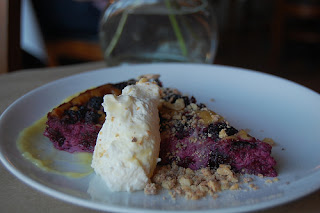Juniper berries
Seitseminen National Park, Finland.
Photograph courtesy of Leo-setä
Juniper berries are not really berries. The so-called berries are the tasty, dried, sour, blue-black, pods or cones that contain the juniper seeds. Fresh juniper pods are rarely seen as they need two years to ripen. So it is the dried juniper pods that are used for their flavor, like a herb. The pods/berries are readily available and keep for a long time and will be found in every French kitchen and I will call them berries in this post.
The juniper is an evergreen bush from the conifer family, and it grows wild all over Europe. The dried pod is behind the flavor in hundreds of sauces, pastries, and of course gin.
Juniperus Communis
The most often seen European juniper tree and berry.
www.flickr.com/photos/biodivlibrary/7845263260/
Juniper berries on French menus:
Dos de Saumon au Chou Alsacien, Beurre Blanc aux Baies de Genièvre – A thick cut of Atlantic salmon prepared with the unique Quintal d'Alsace cabbage served with a beurre blanc sauce flavored with juniper berries. (The Quintal d'Alsace cabbage is a cabbage hybrid that may grow to six or more kilos (13 lbs). Nevertheless, most of these cabbages are picked when quite small, around four kilos(8.8 lbs))!
Les Médaillons de Chamois aux Baies de Genièvre - Round cuts of steak from a young mountain goat from the Alps, the mountain antelope, flavored with juniper berries. A close cousin of this mountain goat is called the isard or izard and found in the Pyrenees where it will be on menus with similar recipes.
Juniper with its clear taste is traditionally used with game dishes. Wild game has a strong flavor, and the juniper provides some competition. Cuts like the menu item above cannot come from an adult as steaks would be far too stringy. The meat from adults will be marinated in wine, flavored with juniper and then stewed.
Cotes de Sanglier à la St. Hubert – Chops from a wild boar prepared in the manner of Saint Hubert. St Hubert (656-727) is the Belgian patron Saint of the Belgian Ardennes’ region and its hunters. The hunters in the French Ardennes, across the border, have similar recipes and are also happy to have St. Hubert look after them. In season, game dishes are on the menus across the whole Ardennes. This dish and many other St. Hubert dishes, were all created for wild game and any will be flavored with juniper berries. The French department of Ardennes is in the new super region of Le Grande Est.
Stewed wild boar with juniper berries
www.flickr.com/photos/donutgirl/6542858367/
Jambon de
Luxeuil or Jambon de Luxeuil Les Bains- This is a cured and smoked ham. It is produced around the spa town of Luxeuil-les-Bains in the north of the department of Haute-Saône in the Bourgogne-Franche-Comté. The ham is marinated in salt and juniper berries and then lightly smoked before being hung for at least nine months. Luxeuil-les-Bains is close to the town of Fougerolles where they make some of France’s best kirsch, the cherry liquor.
Les Rognons de
Veau aux Baies de Genévrier Flambés au Genièvre – Veal kidneys prepared with juniper berries and served flambéed with gin.
La Terrine de
Lapereau aux Baies de Genévrier – A hare pate flavored with juniper berries. (A hare is a lapereau and a rabbit is a lapin).
Ostrich pate with
juniper berries.
www.flickr.com/photos/joedm/110932016/
Tournedos de Magret de Canard Réduction au Quinoa et Genévrier – Thick cuts of duck breast served with a sauce made with the natural cooking liquids along with quinoa and juniper berries.
Even squirrels like juniper berries.
Gin
Behind gin’s popularity as a beverage is the physician Franciscus Sylvius (1614 – 1672). Sylvius was a respected Dutch doctor who recommended mixing juniper pods with alcohol along with other herbs that were sold in pharmacies for treating gallstones, gout and more. The Dutch names for gin are jenever, junever, and genièvre. Since Franciscus Sylvius put the drink on the market, the Dutch distilleries have never looked back. Though how many people have been cured by drinking large quantities of gin is unknown.
The English knew about gin long before the Dutch William of Orange and his wife, Mary became King and Queen of England, Ireland, and Scotland in 1689. Nevertheless, gin’s popularity grew with the Dutch influence. Within 60 years of William and Mary arriving in England, the country was swamped with cheap unlicensed gin shops. Gin became the drink of the poor, and most of the gin sold did not even contain any real juniper berries.
The Dutch universally get the credit for creating gin while the English take the credit for drinking the most gin per capita. The British justified their unlimited consumption of gin when they ruled India. Then they drank gin and tonic, with added quinine, as quinine was part of the fight against malaria.
Tonic water with quinine
Quinine is Phosphorescent
www.flickr.com/photos/azadam/179487975/
The juniper berry, or pod, in the languages of France’s neighbors:
(Catalan – ginebre),(Dutch - jeneverbes), (German - wacholder), (Italian - ginepr), (Spanish - enebro). (Provençal - genèbre), (Latin - juniperus communis).
Behind the French Menu
--------------------------------
Behind the French Menu
by
Bryan G. Newman
behindthefrenchmenu@gmail.com
Copyright 2010, 2013, 2017, 2019
--------------------------------
Searching for the meaning of words, names or phrases
on
French menus?
Just add the word, words, or phrase that
you are searching for to the words "Behind the French Menu" (best
when including the inverted commas), and search with Google, Bing, or another
browser. Behind the French Menu’s links, include hundreds of words,
names, and phrases that are seen on French menus. There are over 450 articles
that include over 4,000 French dishes with English translations and
explanations.
Connected Posts:



















